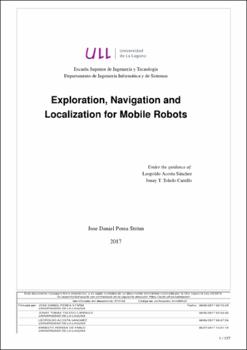Exploration, navigation and localization for mobile robots.
Author
Perea Strom, Jose DanielDate
2017Abstract
he main goal of this thesis is the advancement of the state of the art in mobile robot autonomy. In order to achieve this objective, several contributions have been presented that tackle well defined problems in the areas of localization, navigation and exploration.
The very first contribution is focused on the task of robustly finding the localization of a mobile robot in an outdoor environment. Specifically, the presented technique introduces a key methodolgy to perform sensor fusion of a global localization sensor so ubiquitous as a GPS device, within the context of a particle filter based Monte Carlo localization system. We focus on the management of multiple sensor data sources under noisy and conflicting readings. This strategy allows for a reduced uncertainty in the robot pose estimation, as well as improved robustness of the system.
The second contribution presents a completely integrated navigation system running within a constrained and highly dynamic platform like a quadrotor, applied to full 3D environments. The navigation stack comprises a Simultaneous Localization and Mapping (SLAM) system for RGB-D cameras that provides both the robot pose and an obstacle map of the environment, as well as a 4D path planner capable of finding obstacle free and kinematically feasible trajectories for the quadrotor to navigate this environment.
The third contribution introduces a novel approach for autonomous exploration of unknown environments with robust homing. We present a technique to predict possible environment structures in the unseen parts of the robot's surroundings based on previously explored environments. We exploit this belief to predict possible loop closures that the robot may experience when exploring an unknown part of the scene. This allows the robot to actively reduce the uncertainty in its belief through its exploration actions. Also, we introduce a robust homing system that addresses the problem of returning a robot operating in an unknown environment to its starting position even if the underlying SLAM system fails.
All contributions where designed, implemented and tested on real autonomous robots: a self-driving car, a micro aerial vehicle and an underground exploration platform.





